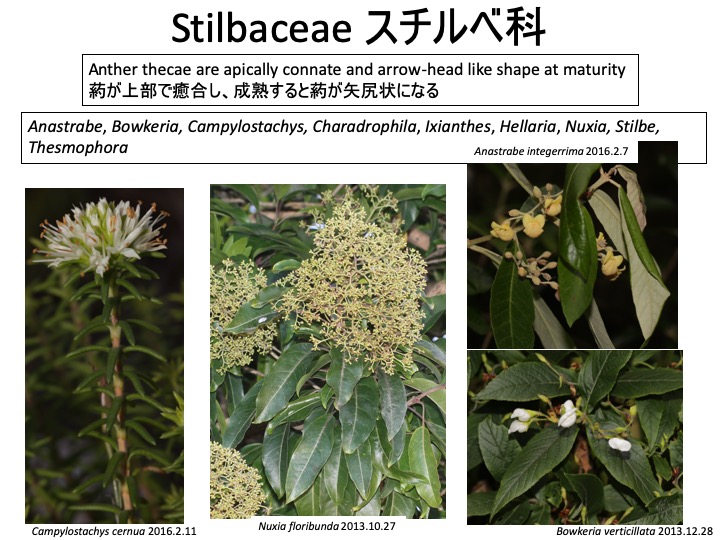
The Stilbaceae includes 8 genera mainly distributed in Africa (Leeuwenberg 1975). Anther thecae are apically connate and arrow-head like shape at maturity.
スチルベ科は8属からなり、主にアフリカに分布する(Leeuwenberg 1975)。葯が上部で癒合し、成熟すると葯が矢尻状になる。


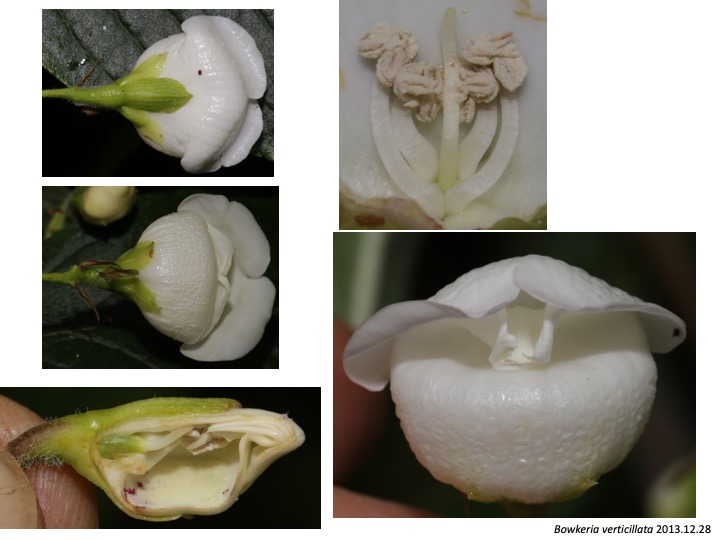
Bowkeria is distributed in South Africa (Harley et al. 2004) and has a saccate petal.
Bowkeriaは南アフリカに分布し(Harley et al. 2004)、下唇が袋状になる。
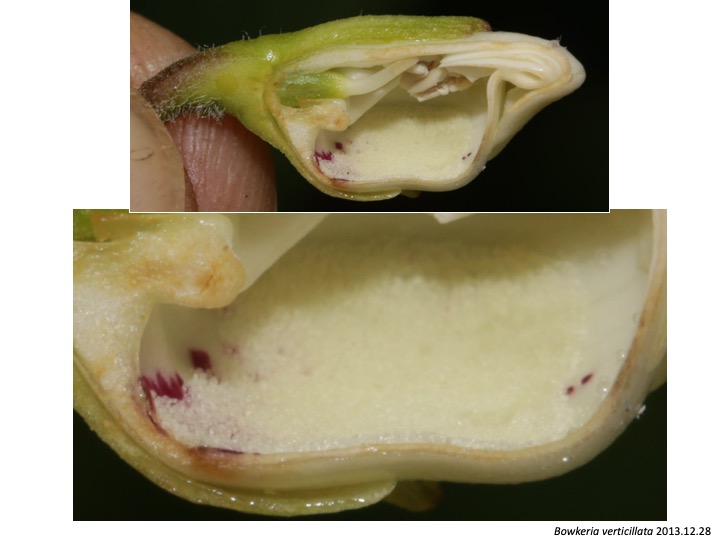
Bowkeria spp. form hairs producing oil on an adaxial side of pouch-shaped lower petals, from which oil bees, such as Redivia collect oil for larve. Rediviva “pallidula” is an oil collecting bee and collects oil by its forelegs from Diascia sp. with various length of spurs (Steiner and Whitehead 1991). The lengths of forelegs and spurs are correlated. On the other hand, R. rufocincta that collects oil from Bowkeria verticillata and B. citrina, which form saccate lower petals with oil producing hairs. The lengths of forelegs are correlated to their body sizes.
Bowkeria verticillataの袋状の花弁の内側は油を分泌する毛が密生しており、油集めバチ oil collecting beesが油を集めにくることで受粉する。油は幼虫の餌となる。
Rediviva “pallidula” は前脚を使って、さまざまな長さの距を持つDiasciaから油を得ており、集団内で体の大きさとは関係無く前脚の長さと距の長さに相関がある (Steiner and Whitehead 1991)。一方、R. rufocinctaは距が無く、花冠が袋状になりその底部に油を分泌するBowkeria verticillataとB. citrinaから油を得ていて、前脚の長さは体の大きさと相関している (Steiner and Whitehead 1991)。

An adaxial side of a lower saccate petal of Bowkeria cymosa is covered with oil hairs.
Bowkeria cymosaでも下側花弁内側は油を出す線毛で覆われている。
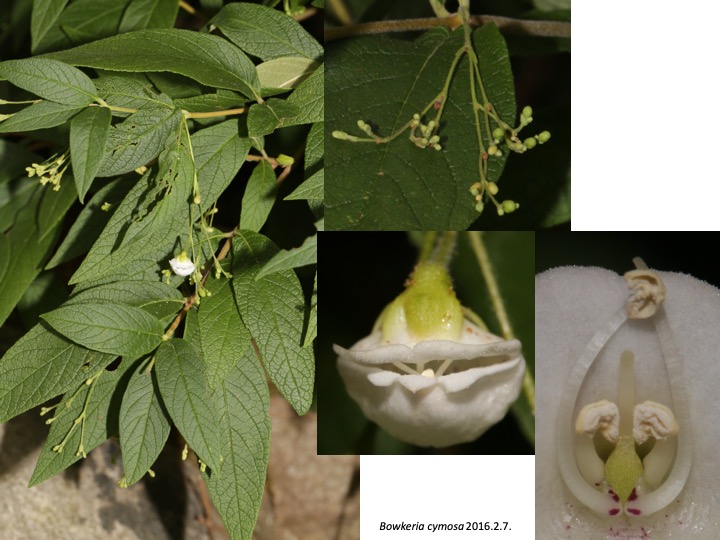
Bowkeria cymosa form more flowers in an inflorescence than Bowkeria verticillata.
Bowkeria cymosaはBowkeria verticillataよりも1花序にたくさんの花を着ける。

The morphology of capsules in Bowkeria is similar to that of Nuxia in the same family.
Bowkeriaの蒴果の形は同じ科のNuxiaに似ている。

Anastrabe is a monotypic species native in South Africa. Anastrabe is different from Bowkeria with 5-fid and valvate calyx lobe (5-partite and imbricate in Bowkeria), opposite leaves (ternate leaves in Bowkeria), and stellate hairs on leaves, inflorescence stems, calyx, and corolla (no hair or simple hair in Bowkeria) (Harley et al. 2004).
Anastrabeは単系属で南アフリカに自生するAnastrabe integerrimaのみを含む (Harley et al. 2004)。Bowkeriaに近縁で同じく下唇が袋状になるがガク片が敷石状で浅裂(Bowkeriaは瓦重ね状で深裂)、葉が対生(Bowkeriaは3輪生)、花弁や葉に星状毛を持つ(花弁は無毛で葉は単細胞の毛を持つ)する点が異なっている (Hilliard 1969)。両属は1つの属にまとめても良いように思う。

Campylostachys is a monocarpic genus including Campylostachys cernua, which is distributed in Western Cape of South Africa (Harley et al. 2004).
Campylostachys属は、Campylostachys cernuaのみが南アフリカの西ケープ地方に自生する(Harley et al. 2004)。


Four petals. 花弁が4枚。
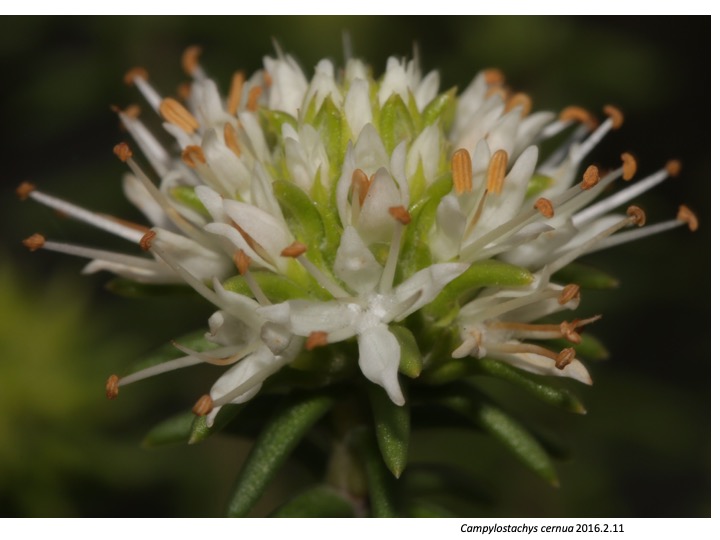

Nuxia is distributed from South Africa to north to southern Arabia (Harley et al. 2004). Nuxia is special to be a tree in the Stilbaceae and has an expanded blade rather than ericoid leaves in other species in the Stilbaceae (Harley et al. 2004).
Nuxia属は南アフリカからアラビア南部にまで分布する(Harley et al. 2004)。スチルベ科には珍しく灌木から低木となり、広がった葉身を持つ点で細い葉を持つ同科の他の種と異なっている(Harley et al. 2004)。


Stilbe includes seven species from West Cape in South Africa (Harley et al. 2004).
Stilbe属は7種が南アフリカの西ケープに分布する(Harley et al. 2004)。

Ericoid leaves are whorled. 細く厚いエリカ葉が輪生する。
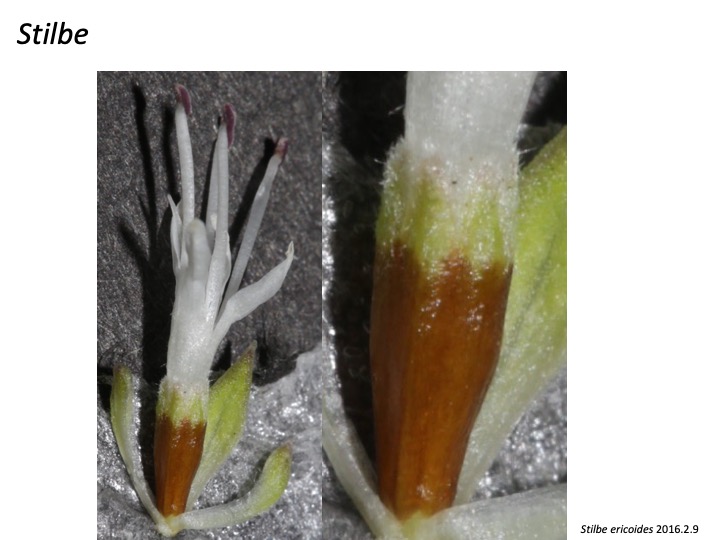
Sepals are connate in Stilbe. スチルベ属のガク片は癒合する。



Kogelbergia is similar to Stilbe but flowers are actinomorphic and petals are glabrous.
KogelbergiaはStilbeに似ているが、花が放射相称であるとともに花弁に毛が生えている。
Harley, R.M., Atkins, S., Budantsev, A.L., Cantino, P.D., Conn, B.J., Grayer, R., Harley, M.M., De Kok, R., Krestovskaja, T., Morales, R., et al. (2004). Labiatae. In The Families and Genera of Vascular Plants VII, K. Kubitzki, and J.W. Kadereit, eds. (Berlin Heidelberg: Springer), pp. 167–275.
Hilliard, O.M. (1969). Bowkeria and Anastrabe: Two woody South African Scrophylariaceae. Notes Roy. Bot. Gard. Edinburgh 29, 1–14.
Leeuwenberg, A. J. M. 1975. The Loganiaceae of Africa XIV. A revision of Nuxia Lam. Meded. Landbouwho. Wageningen 75(8): 1-80.
Steiner, K.E., and Whitehead, V.B. (1991). Oil flowers and oil bees: further evidence for pollinator adaptation. Evolution (N. Y). 45, 1493–1501.
